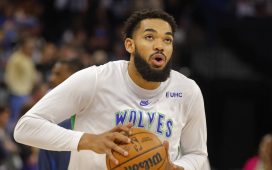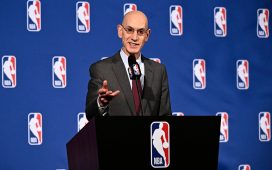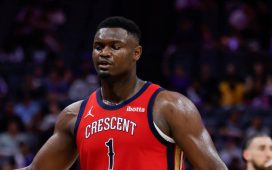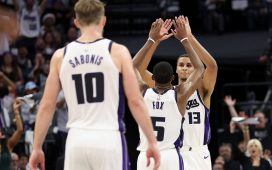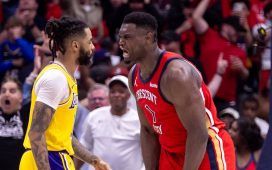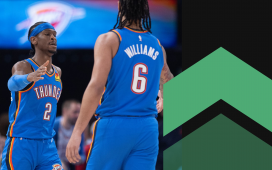The N.B.A. on Thursday is scheduled to announce the players chosen by Eastern and Western Conference coaches as All-Star Game reserves. On the internal calendar I keep, this is traditionally the ideal time to unveil my unofficial All-Star selections.
That won’t be happening this time.
In the wake of the horrific helicopter crash on Sunday that killed the legendary Kobe Bryant and eight others aboard, normal operations have been pretty much suspended for anyone who has anything to do with the N.B.A.
Bryant’s worldwide stature is obviously a huge part of that. He was one of the giants of this game, an immense figure globally, revered by the overwhelming majority of current N.B.A. players — and incomprehensibly struck down at the age of 41. Grief like this will not fade quickly.
It is doubly true in this case because Bryant’s 13-year-old daughter, Gianna, was on that helicopter with him.
Beloved by members of the University of Connecticut women’s basketball program, which she dreamed of joining someday, Gianna received a moving tribute from the team on Monday when it placed flowers and a UConn jersey bearing her No. 2 on the bench for an exhibition game against the United States national team.
“Mambacita is forever a Husky,” the school posted on Twitter, referring to the nickname that Kobe Bryant, the self-styled “Black Mamba,” had given the second-born of his four daughters.
Also on board were two of Gianna’s teammates from the AAU squad coached by her father: Alyssa Altobelli and Payton Chester. The lives of three teenage girls with so much to look forward were taken in the crash, along with those of Bryant; Alyssa’s parents, John and Keri; Payton’s mother, Sarah; Kobe’s assistant coach, Christina Mauser; and Ara Zobayan, who piloted the helicopter.
The list gets sadder every time it is recited.
Kobe Bryant was 17 when I met him, then freshly acquired by the Los Angeles Lakers. On Monday, I wrote about how he was convinced, from the first minute of his pro career, that he was bound for the Hall of Fame.
Bryant was equally convinced that Gianna was likewise destined for greatness. She was his ever-present companion at countless games in recent years — to watch her W.N.B.A. heroes, or the Huskies, or maybe on a special trip to see her favorite N.B.A. player: Trae Young of the Atlanta Hawks.
Perhaps by now you have seen the clip of Kobe from his visit to the “Jimmy Kimmel Live” show in 2018, telling the world that Gianna bristled any time she heard a fan suggest to her father that he and his wife, Vanessa Bryant, needed to have a boy to uphold Kobe’s legacy.
“She’s like, ‘Oy, I got this,’” Bryant said of Gianna, then 12.
The last time I saw Kobe, on Dec. 29 at Staples Center, he had never looked more joyful. Wearing a bright orange hoodie and a green ski cap to rep his hometown Philadelphia Eagles, Bryant was sitting courtside beside Gianna as they watched — make that studied — the Lakers’ LeBron James and Luka Doncic of the Dallas Mavericks going head-to-head.
Also in the building that night was God Shammgod, whose extraordinary dribbling ability made him a New York playground legend. Despite the briefest of N.B.A. playing careers, Shammgod has landed on the Mavericks’ staff as a player development coach — yet he remains so revered for his ball handling that, even in a coaching role, he has his own Puma signature shoe.
Days after that Lakers/Mavericks game, never realizing the sorrow that was looming, Shammgod told me some moving stories of his workouts with father and daughter — how he had the extraordinary opportunity to coach them both.
“I knew him when he wasn’t this Kobe,” Shammgod said. “He knew me when there was no Shammgod moves.”
In their high school days, Shammgod — then known as Shammgod Wells — wound up at an ABCD youth camp with Bryant in New Jersey. Kobe had spent some of his formative years in Italy, where his father, Joe “Jellybean” Bryant, was playing professionally, but Shammgod said Kobe’s fellow campers knew only that he had mostly played abroad somewhere.
“The boy from France,” Shammgod said. “That’s what we called him. After the first game, guys were saying, ‘Who’s this guy who actually thinks he’s Michael Jordan?’ He’s walking like Jordan, he’s doing every Jordan move, shooting all the balls.”
Bryant was clearly a special talent, but his ball handling was a weakness. Joe Bryant had noticed Shammgod’s slick handles and asked the 16-year-old if he could help Jellybean’s 15-year-old son.
Shammgod told the elder Bryant that he would be happy to work out with Kobe — at 6 the next morning. “I was thinking, ‘He’s not going to show,’” Shammgod said. “I get there and he’s already there.”
A bond was forged, and the two remained close. The friendship endured even as Bryant rose to stardom and his dribbling mentor was forced to scour the globe for jobs (in Poland, China, Saudi Arabia, Kuwait and Croatia) after an N.B.A. career that lasted just 20 games with the Washington Wizards in 1997-98.
During the All-Star break last February, Shammgod received an urgent summons from Bryant to Southern California. Kobe was now coaching Gianna’s travel team and wanted to introduce her and the rest of the squad to the move known in hoop parlance as “The Shammgod” — which requires the dribbler to bring the ball to the side with one hand to get the defender off balance, then snatch it back with the opposite hand to execute a crossover dribble. Oklahoma City’s Chris Paul and the Nets’ Kyrie Irving are two of the most accomplished modern practitioners.
Shammgod spent two days at Bryant’s Mamba Sports Academy in Thousand Oaks, Calif.
“When I say that’s all he wanted to do is dribbling, that’s all he wanted to do,” Shammgod said. “From 10 to 12 in the morning, then from 2 to 4. These girls were dribbling four hours straight without shooting the basketball.”
One-on-one tutorials with Gianna would soon follow. Shammgod said they had worked out about a dozen times over the past year. Kobe wanted to fly him in more often, but Shammgod said he had to remind him occasionally, “I work for the Mavs and I can’t leave.”
When the trio huddled at that Dec. 29 game at Staples, Gianna excitedly told the story of how she “did the Shammgod on this girl” in a recent game.
“She was so locked in,” Shammgod said. “Her mind-set was just like his mind-set.”
That was evident in a 2019 glimpse of Gianna on camera with the Las Vegas CBS affiliate during a trip to watch that season’s opener for the W.N.B.A.’s Las Vegas Aces. Explaining her fascination with film study, Gigi could not have sounded much more like her father when she said, “More information, more inspiration.”
Those of us who were there for the start of the Kobe Bean Bryant experience and watched him grow up can’t help but flash back to those early days now. Even though the journalism handbook says we’re supposed to be detached and unemotional — even at times like this — Bryant’s sudden death has been a gut punch for many scribes like me who covered him closely over the past two decades.
What messes me up most, though, is when I start thinking about Gianna Maria-Onore Bryant, her two teammates on that chopper and the shattered families that have to try to move on without them.
Gianna, Alyssa and Payton — gone at an age just a few years younger than Kobe was upon his league-shaking arrival in the N.B.A. So, so unspeakably cruel.
This newsletter is OUR newsletter. So please weigh in with what you’d like to see here. To get your hoops-loving friends and family involved, please forward this email to them so they can jump in the conversation. If you’re not a subscriber, you can sign up here.
In tribute to Kobe Bryant and his second of two jersey numbers, we present a 24-item assemblage of standout statistics from his career with the Lakers.
18
Bryant was the youngest player in N.B.A. history when he made his regular-season debut for the Lakers on Nov. 3, 1996, at 18 years and 72 days old. A future teammate with the Lakers, Andrew Bynum, eventually became the youngest player in league history at 18 years and six days old when he made his debut in 2005.
4
Only four players — all big men — made the jump directly from high school to the pros before Bryant and Portland’s Jermaine O’Neal were selected in the 1996 N.B.A. draft. Those four predecessors: Moses Malone, Darryl Dawkins, Bill Willoughby and Kevin Garnett. Shawn Kemp sat out a year after graduating high school in 1988 before he was drafted in 1989 by Seattle.
1,346
Both of the Lakers’ rookies selected in the first round of the 1996 N.B.A. draft — Bryant (1,346) and Derek Fisher (915) — rank in the top five in club history in games played.
7
Bryant started only seven games in his first two N.B.A. seasons.
4
Bryant’s four air balls in a 1997 playoff game in Utah — one at the regulation buzzer and three in overtime — came against the same Jazz franchise he riddled for 60 points in his final N.B.A. game on April 13, 2016.
3
The Lakers’ championships in three consecutive seasons — 1999-2000, 2000-01, 2001-02 — represent the league’s only three-peat this century. The Michael Jordan-led Chicago Bulls had three-peats twice in the 1990s (1990-91 through 1992-93 and 1995-96 through 1997-98).
38.3
A conversion rate of 38.3 percent in 2002-03 marked Bryant’s most successful season from the 3-point line.
35.4
Bryant’s highest single-season scoring average was 35.4 points per game in 2005-2006, the Lakers’ second season after trading away Shaquille O’Neal.
16,866
Bryant scored 16,866 points and won three of his five championships wearing No. 8 through his first 10 seasons.
16,777
He scored 16,777 points and won two championships wearing No. 24 over the final 10 seasons of his career.
20
Bryant’s 20 consecutive seasons with the Lakers left him one shy of the N.B.A. record for playing with only one team: Dirk Nowitzki’s 21 seasons with the Dallas Mavericks.
14
No other Laker played more than 14 seasons (Jerry West and Kareem Abdul-Jabbar).
81
Bryant scored 81 points against the Toronto Raptors on Jan. 22, 2006.
33
Bryant’s eruption against the Raptors, the second-highest scoring output in league history behind Wilt Chamberlain’s 100-point game in 1962, came just 33 days after Kobe scored 62 points in three quarters against the Dallas Mavericks.
220
Bryant appeared in 220 career playoff games, which equates to more than two and half seasons of extra wear and tear.
4
The Lakers missed the playoffs in each of Bryant’s last four seasons.
35.6
Bryant averaged just 35.6 games played over his final three seasons following his torn left Achilles’ tendon in April 2013.
11
The 60 points Bryant scored in his farewell outing beat the previous record for an N.B.A. player in his last official season by 11 points. Boston’s Larry Bird scored 49 points on March 15, 1992.
1
Bryant is the only player in league history to have two jersey numbers (No. 8 and No. 24) retired by one franchise.
18
Bryant’s 18 N.B.A. All-Star appearances are one shy of Kareem Abdul-Jabbar’s record 19.
3
Bryant was voted in by fans as an All-Star starter in his third season with the Lakers and in each of the subsequent 17 seasons.
$328,238,062
The value of Bryant’s contracts over 20 seasons with the Lakers, according to Basketball Reference, was nearly $330 million.
0
Bryant and LeBron James never met in a playoff game. James has made nine trips to the N.B.A. finals, winning three titles.
5-2
Bryant posted a career record of 5-2 in the N.B.A. finals, winning five championships in seven appearances.
Hit me up anytime on Twitter (@TheSteinLine) or Facebook (@MarcSteinNBA) or Instagram (@marcsteinnba). Send any other feedback to marcstein-newsletter@nytimes.com.
